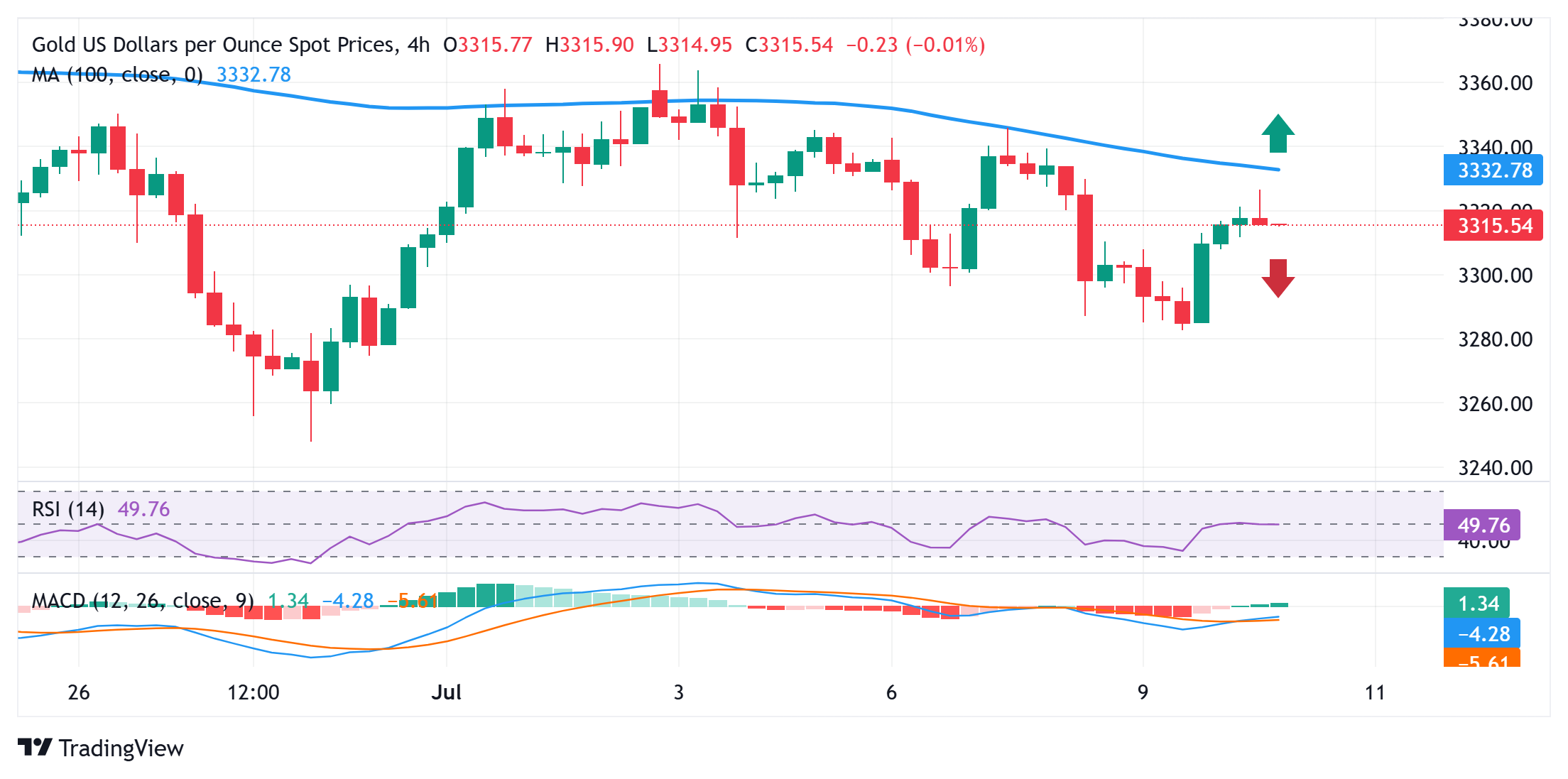- Gold price scales higher for the second straight day amid a combination of supporting factors.
- Trade jitters act as a tailwind for the safe-haven XAU/USD pair on the back of a softer USD.
- Declining US bond yields and Fed rate cut bets further benefit the non-yielding yellow metal.
Gold price (XAU/USD) is building on the overnight bounce from a one-and-a-half week low and gaining positive traction for the second straight day on Thursday. Investors remain on edge amid uncertainties surrounding US President Donald Trump’s erratic trade policies and their impact on the global economy. Adding to this, prospects for interest rate cuts by the Federal Reserve (Fed) this year and subdued US Dollar (USD) price action turn out to be key factors that act as a tailwind for the non-yielding yellow metal through the early European session.
Meanwhile, traders pared bets on the number of Fed cut rates this year following the release of the upbeat US employment data last Thursday, which showed that the economy added more jobs than expected in June. Moreover, Minutes from the June FOMC meeting released on Wednesday revealed that only a couple of officials felt interest rates could fall as soon as this month in anticipation of a tariffs-driven rise in inflationary pressures. This, along with a generally positive tone around the equity markets, might keep a lid on any further gains for the safe-haven Gold price.
Daily Digest Market Movers: Gold price retains positive bias amid trade uncertainties and softer USD
- US President Donald Trump issued tariff notices to eight minor trading partners on Wednesday and said that there will be no extensions for the countries that receive letters. Furthermore, Trump stressed that any retaliatory levies will be added to the existing US tariffs.
- Adding to this, Trump announced that the 50% tariff on copper imports will take effect on August 1. This adds a layer of uncertainty in the markets and turns out to be a key factor driving some follow-through safe-haven flows towards the Gold price on Thursday.
- Minutes from the Federal Reserve’s June 17-18 policy meeting revealed that most policymakers remain worried about the risk of rising inflationary pressure on the back of Trump’s aggressive trade policies. Moreover, some policymakers felt that no rate cut would be needed at all.
- However, most participants expected that rate cuts would be appropriate later this year and that any price shock from tariffs would be temporary or modest. This contributed to the fall in the US Treasury bond yields, triggered by a strong 10-year government debt auction.
- The US Dollar extends its retracement slide from a two-week high for the second straight day and turns out to be another factor that benefits the XAU/USD pair. Traders now look forward to the release of US Weekly Jobless Claims and speeches by Fed officials for a fresh impetus.
Gold price approaches 100-SMA pivotal hurdle on H4 amid short-term bearish technical setup

From a technical perspective, the 100-period Simple Moving Average (SMA) on the 4-hour chart, currently pegged near the $3,335 region, could cap any subsequent move up for the Gold price. This is followed by the $3,358-3,360 supply zone, which, if cleared, might trigger a short-covering move and allow the XAU/USD pair to reclaim the $3,400 round figure.
On the flip side, weakness below the $3,300 mark would expose the overnight swing low, around the $3,283-3,282 region. Some follow-through selling would make the Gold price vulnerable to accelerate the fall towards retesting the July monthly swing low, around the $3,248-3,247 region.
Fed FAQs
Monetary policy in the US is shaped by the Federal Reserve (Fed). The Fed has two mandates: to achieve price stability and foster full employment. Its primary tool to achieve these goals is by adjusting interest rates.
When prices are rising too quickly and inflation is above the Fed’s 2% target, it raises interest rates, increasing borrowing costs throughout the economy. This results in a stronger US Dollar (USD) as it makes the US a more attractive place for international investors to park their money.
When inflation falls below 2% or the Unemployment Rate is too high, the Fed may lower interest rates to encourage borrowing, which weighs on the Greenback.
The Federal Reserve (Fed) holds eight policy meetings a year, where the Federal Open Market Committee (FOMC) assesses economic conditions and makes monetary policy decisions.
The FOMC is attended by twelve Fed officials – the seven members of the Board of Governors, the president of the Federal Reserve Bank of New York, and four of the remaining eleven regional Reserve Bank presidents, who serve one-year terms on a rotating basis.
In extreme situations, the Federal Reserve may resort to a policy named Quantitative Easing (QE). QE is the process by which the Fed substantially increases the flow of credit in a stuck financial system.
It is a non-standard policy measure used during crises or when inflation is extremely low. It was the Fed’s weapon of choice during the Great Financial Crisis in 2008. It involves the Fed printing more Dollars and using them to buy high grade bonds from financial institutions. QE usually weakens the US Dollar.
Quantitative tightening (QT) is the reverse process of QE, whereby the Federal Reserve stops buying bonds from financial institutions and does not reinvest the principal from the bonds it holds maturing, to purchase new bonds. It is usually positive for the value of the US Dollar.







